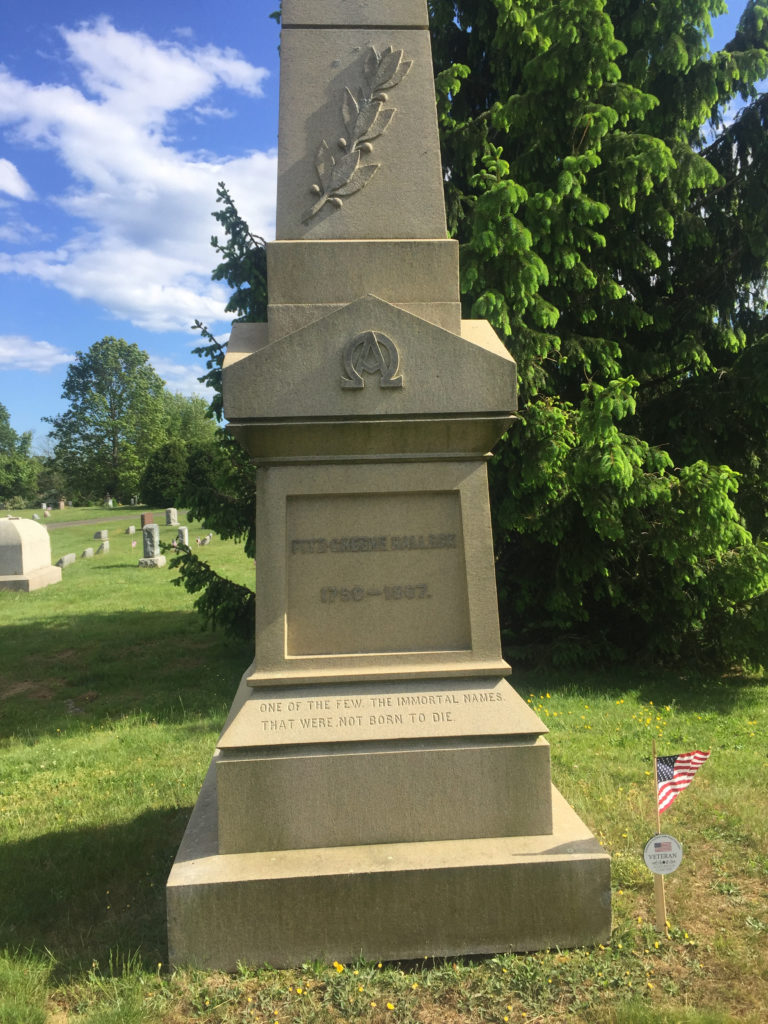Erik Visits an American Grave, Part 829
This is the grave of Fitz-Greene Halleck.

Born in 1790 in Guilford, Connecticut, Halleck grew up in middling circumstances, the son of a store owner. When he was 2, he lost much of hearing when he somehow was next to soldiers who fired off the weapons. He lost all the hearing in his left ear and I believe a bit in his right as well. He went to local schools, was introduced to poetry by his teacher Samuel Johnson Jr., who was not related to the legendary British writer but who was the compiler of the first dictionary in American history. Still, it didn’t seem that Halleck would grow up to be anything too special, leaving school at the age of 15 to work in his father’s store.
By 1811, Halleck had enough of home. He moved to New York to find work. But he couldn’t find any. It just wasn’t working out. He was about to give up and try his hand in Richmond when he got a job in a bank. That was owned by Jacob Barker, who became a leading financier and who would be a mentor and patron of his young employee soon to rise in American cultural circles.
Halleck first got the attention of the small American literary world in 1819, when he and his friend Joseph Rodman Drake anonymously published a series of poems satirizing New York society called The Croaker Papers. Both became part of the Knickerbocker Group soon after with people such as William Cullen Bryant, James Fenimore Cooper, and Washington Irving. He became a pretty successful poet, selling his work for a good amount of money. This allowed him to visit Europe in the late 1820s. By 1830, he was known nationally as the American Byron. By 1832, he found a new patron. John Jacob Astor hired him as his private secretary whose real task was to advise the fur capitalist on what art to buy. This gave Halleck long-term financial stability. When Astor died in 1848, the cheap old man only left Halleck $200 a year for all his work, though his son raised it to a more reasonable $1,500 a year. Halleck also was an original trustee of the Astor Library, which was the precursor to the New York Public Library.
Halleck retained a wide readership through his life. He only published two volumes of poems, one in 1819 and one in 1827, but was in many anthologies. Today he’s basically not read at all, which isn’t surprising since early American literature generally is fairly inaccessible and that’s especially true of the poetry. But Halleck still has the attention of many literature scholars. That’s largely because not only was he popular, but he was also fairly openly gay. I don’t really know about consummated relationships. It’s clear he was love with Joseph Rodman Drake. He was the best man at Drake’s wedding but clearly wanted more. Incidentally, when Drake died young, his widow was interested in marrying Halleck, but that did not happen. His clear homosexual desires were clear enough at the time that the first gay American novel, written in 1870 by Bayard Taylor and titled Joseph and His Friend, was a fictionalized account of their relationship. Scholars have mined Halleck’s work for homosexual themes, which are right there on the surface.
Toward the end of his life, Halleck stopped writing and moved back to Guilford to live with his sister. He died there in 1867, at the age of 77. When he died, Halleck was a big enough deal that not only was there a statue of him placed in Central Park in 1877, but it was dedicated by none other than President Rutherford Hayes in front of a crowd of 10,000 people.
Fitz-Greene Halleck is buried in Alder Brook Cemetery, Guilford, Connecticut.
If you would like this series to visit other American poets, you can donate to cover the required expenses here. Emily Dickinson is in Amherst, Massachusetts and Robert Frost is in Bennington, Vermont. Previous posts in this series are archived here.
